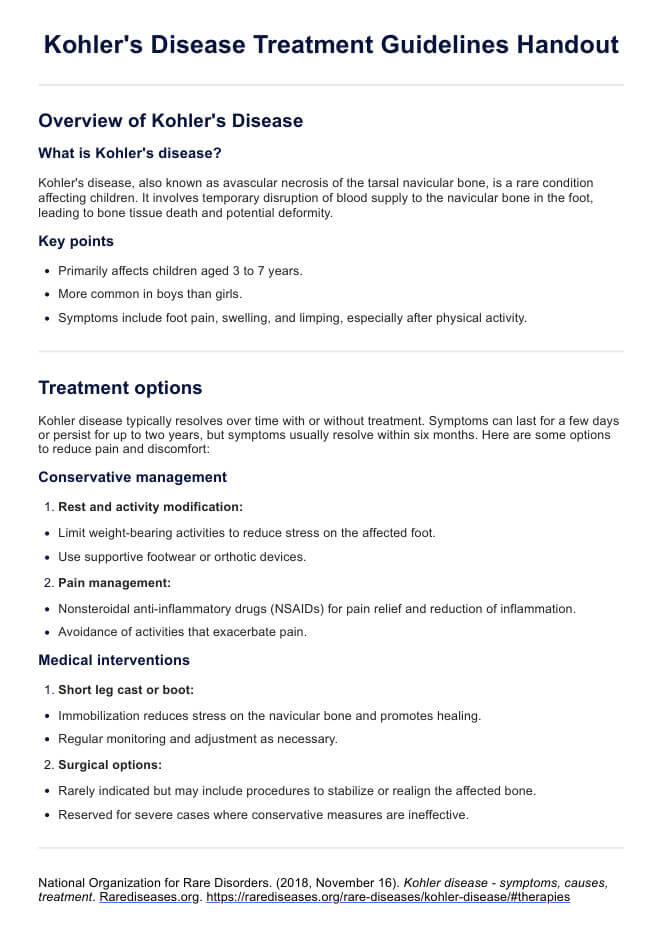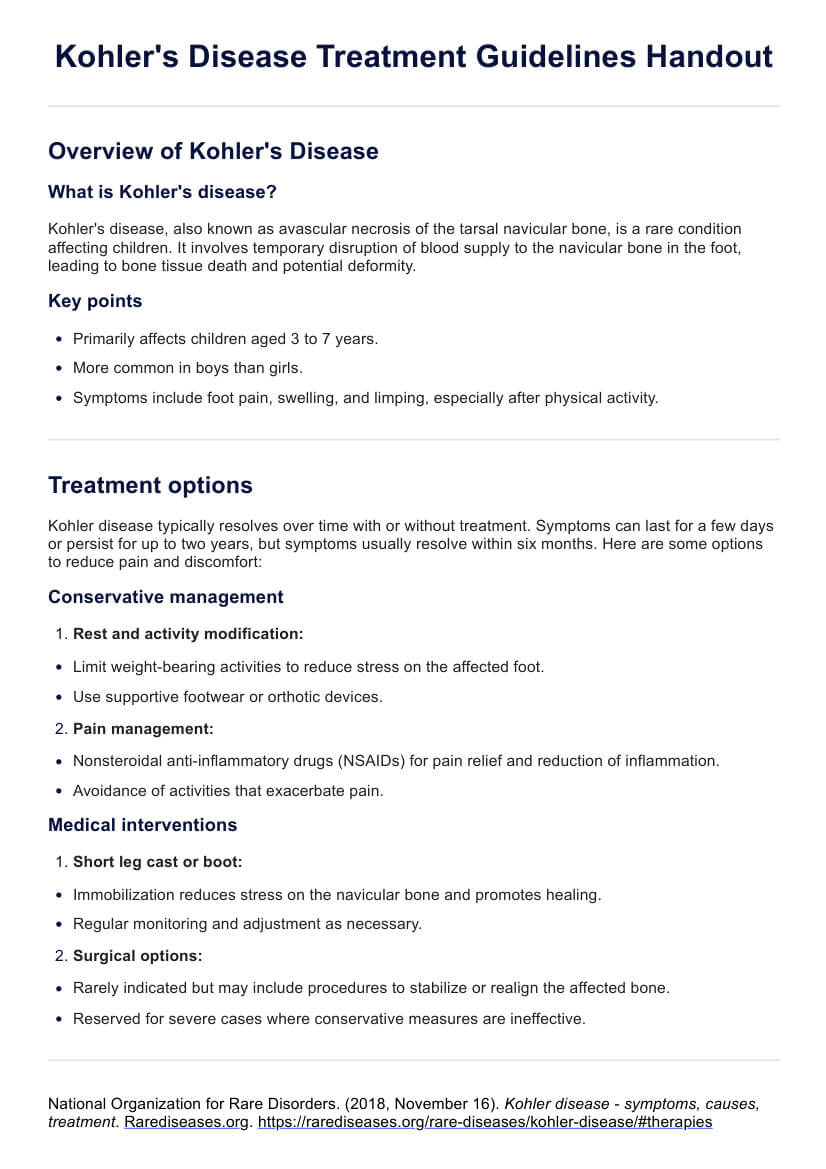Kohler's Disease Treatment Guidelines Handout
Get comprehensive treatment guidelines and an example plan for Kohler's Disease in Carepatron's free PDF download. Learn about effective treatment strategies and management options.


What is Kohler's disease?
Kohler's disease, also known as Köhler disease or avascular necrosis of the tarsal navicular bone, is a rare bone disorder primarily affecting children. It occurs due to temporary disruption of blood supply to the tarsal navicular bone, which is a small bone in the foot essential for maintaining its arch. This condition leads to avascular necrosis, a process where bone tissue dies due to lack of blood supply and blood vessels. As a result, the affected bone may become painful, swollen, and tender.
Typically diagnosed between the ages of 3 and 7 years, Kohler's disease predominantly affects boys more than girls. Symptoms often include limping or difficulty walking, particularly after physical activity. Diagnosis involves clinical evaluation, X-rays, and other bone imaging techniques to confirm delayed bone formation characteristic of avascular necrosis.
Treatment options vary based on the severity of symptoms and may include conservative measures such as rest, pain relievers, and supportive footwear to alleviate discomfort while the bone heals naturally. In more severe cases, orthopedic surgery might be necessary to alleviate pain and restore normal bone function. Although Kohler's disease is rare, prompt diagnosis and appropriate treatment can help manage symptoms effectively.
Kohler's Disease Treatment Guidelines Handout Template
Kohler's Disease Treatment Guidelines Handout Sample
Treatment for Kohler's disease
Kohler's disease, though rare, requires careful management to alleviate symptoms and promote healing of the affected tarsal navicular bone in the foot. Treatment options vary depending on the severity of the condition and individual circumstances.
Conservative management
Conservative treatments aim to reduce pain and support natural healing processes. In mild cases, especially when symptoms are not severe, simply limiting physical activities that stress the affected foot and providing adequate rest may be sufficient. This approach allows the bone to heal naturally over time.
Nonsteroidal anti-inflammatory drugs (NSAIDs) or other pain relievers can help manage discomfort associated with Kohler disease. These medications are often prescribed to reduce inflammation and relieve pain during the healing process.
Using supportive footwear or orthotic devices can help distribute pressure evenly across the foot, reducing stress on the affected bone. This approach promotes comfort and supports natural healing.
Medical interventions
In cases where conservative measures are insufficient, medical interventions may be considered.
Applying a short leg cast or a removable walking boot can immobilize the foot and reduce stress-related compression on the navicular bone. This immobilization supports healing by preventing further damage and allowing the bone to repair itself.
For more severe cases or when conservative treatments fail, orthopedic surgery may be necessary. Surgical procedures aim to alleviate pain, restore proper bone alignment, and improve function. Surgical options may include bone realignment, bone grafting, or fixation with screws or pins to stabilize the affected bone.
Future perspectives
Research into Köhler's bone disease continues, exploring genetic factors, abnormal strain on the navicular bone, and structural weakness that may contribute to its development. Advancements in sports medicine and orthopedics contribute to improved treatment strategies, particularly for a young athlete affected by these rare disorders.
How to use our treatment guidelines handout template?
Our treatment guidelines handout template for Kohler's disease provides a structured approach to managing this rare bone disorder effectively. Here’s how you can utilize the template to enhance treatment outcomes:
Step 1: Understanding Kohler's disease
Begin by familiarizing yourself with the basics of Köhler disease, including its causes, symptoms, and diagnostic procedures. This knowledge forms the foundation for implementing appropriate treatment strategies.
Step 2: Assessing patient specifics
Before using the template, conduct a thorough assessment of the patient's condition. Consider factors such as the severity of symptoms, the stage of bone degeneration, and any underlying medical conditions that may impact treatment decisions.
Step 3: Tailoring treatment approaches
Utilize the template to tailor treatment approaches based on the individual patient's needs. Incorporate recommended interventions such as rest, foot pain management strategies, and orthopedic interventions as indicated by the severity of symptoms.
Step 4: Monitoring and follow-up
Outline a schedule for monitoring the patient's progress and scheduling follow-up appointments. This step ensures that treatment outcomes are assessed regularly and adjustments to the treatment plan can be made if necessary.
Step 5: Educating patients and caregivers
Use the template to create educational materials that explain Kohler's disease, treatment options, and self-care strategies. Empowering patients and caregivers with knowledge fosters active participation in the treatment process and promotes long-term adherence to therapeutic recommendations.
Step 6: Long-term follow-up
Emphasize the importance of long-term follow-up to monitor for recurrence of symptoms or complications. This ensures ongoing management of Köhler disease beyond initial treatment phases, promoting sustained pain relief and optimal foot function.
Benefits of using this handout
Our Kohler Disease Treatment Guidelines Handout offers several advantages for healthcare practitioners managing patients with this rare bone disorder. Here are five key benefits:
Comprehensive treatment overview
Provides a structured overview of Kohler disease, including its causes, symptoms, and diagnostic procedures, aiding in a thorough understanding for effective treatment planning.
Evidence-based treatment recommendations
Incorporates evidence-based strategies supported by current research and clinical guidelines, ensuring that treatment decisions are based on the latest scientific insights.
Customizable treatment plans
Allows healthcare providers to tailor treatment plans according to individual patient needs, considering factors such as age, severity of symptoms, and response to initial therapies.
Enhanced patient education
Empowers patients and caregivers with clear, accessible information about Kohler disease, its management options, and self-care strategies, promoting active participation in treatment decisions.
Streamlined communication and coordination
Facilitates clearer communication between healthcare providers, patients, and caregivers, promoting coordinated care and reducing the likelihood of treatment gaps or misunderstandings.
Commonly asked questions
Kohler's disease typically resolves on its own as the affected bone regains blood supply and heals naturally. Treatment focuses on managing symptoms and supporting the bone's recovery process.
Treatment may include rest, pain management with medications, supportive footwear, and in severe cases, orthopedic interventions such as casting or surgery to stabilize the affected bone.
Kohler disease is considered rare, primarily affecting children between the ages of 3 and 7 years old, with boys more commonly affected than girls.
Untreated osteonecrosis, such as in Kohler's disease, can lead to progressive degeneration of the affected bone, chronic pain, and potentially permanent damage, affecting mobility and quality of life. Early intervention is crucial to prevent long-term complications.







































































































